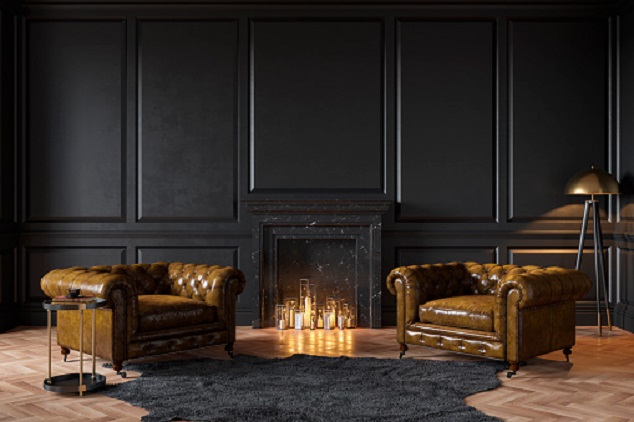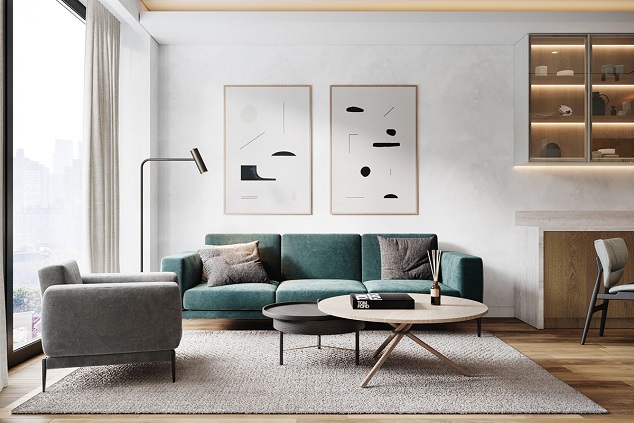Whether it is used as a decor element in the corner of a lounge room, study, or bedroom, or as part of a larger, more convivial set-up of a living room, an armchair is an exquisite addition to any space. One of the most important things you will need to consider before buying this piece of furniture is the upholstery fabric it is made of.
Leather
You usually think of comfort, refinement, and high fashion when you think of leather furniture. From vintage cigar and saddle-style to reclining lounge design, if you want to push back and relax, you can find a leather armchair for every style and decor out there. This natural upholstery material is a long-lasting, versatile, and fashionable choice for your well-appointed living room. Leather, like every other fabric, has advantages and disadvantages. Weighing these different aspects will assist you in determining whether or not it is the best choice for your home décor.

Genuine leather is a natural product that is warm and durable and has specific features that make each hide unique. Genuine leather will always carry the signs of its natural origin, which might appear as scratches, growth markings, areas of varying fibre density, and hair pore texture. These attributes do not detract from the leather’s wearability.
The Different Types of Leather
Full-grain leather is the most natural leather and is never sanded, polished, or snuffed to erase irregularities in the grain. This gives the leather a distinct appearance and helps it to become more breathable. Full-grain leather is the best grade leather available, and it is available in aniline and semi-aniline finish.
The most common type of leather seen in high-end leather items and the second-highest grade is the top grain leather. This leather has had the split layer removed, making it thinner and more supple and suitable for furniture. Also known as “split leather,” it is made from the fibrous part of the hide that remains after the top-grain has been extracted.
Aniline leather is leather that has been dyed to retain its original grain and texture. This results in the most natural-looking leather with apparent natural surfaces. On the other hand, aniline leather is more prone to scratching, staining, and fading. Pigments are used to cover flaws in semi-aniline leather for a more uniform appearance. It falls between aniline and coloured leather and has a more natural look.
The pigmented leather treatment is the most durable, but it sacrifices the natural leather appearance. Pigmented leather will seem more homogeneous and will have fewer flaws.
Maintenance Tips
If you think there is no need to take care of leather – you are wrong, it’s absolutely necessary, and there are specific ways to maintain your leather chairs. First, brush off any dirt or dust collected on the surface of your leather armchair using a soft cloth. Use a vacuum with a soft brush attachment to get into the nooks and crannies of your sofa.
Then, use a moist towel to clean the fabric. If possible, use distilled water since chlorine in tap water can degrade the polish of leather over time. Before you do this for the first time, test how the material reacts to water on a hidden portion of the armchair. Be careful not to saturate your sofa since leather does not tolerate significant amounts of moisture.
Use a special cleaning agent to treat and sanitize your sofa’s upholstery at least once every two to four weeks. Avoid using store all-purpose wipes and sprays. Instead, use a mild cleanser that has been proved to work with leather, such as aniline, semi-aniline, and coloured leather. After you have done your work, allow it to dry naturally, you may speed up the process by opening a few doors and windows and allowing fresh air to flow throughout your home.
Velvet

Velvet is a very versatile fabric that works well in various applications. It may be used to reupholster both small and big pieces of furniture, such as footstools and chairs, as well as couches and headboards. You may even use it to build complementary accessories like pillows and drapes. Velvet has a sumptuous sense to it, and it may help to glam up the look and style of a room, making it feel more sophisticated. However, it is also at home in a more comfortable and relaxed setting, where its soft touch can provide a welcoming and warming sense to a place.
If you thought that velvet fabric would be difficult to clean, think again. To clean velvet furniture, use a brush to wipe the surface clean, or use a vacuum cleaner’s hand-held attachment to keep velvet furniture clean and dirt-free. To properly clean it, like with other materials, it’s preferable to deal with stains and spills right away rather than after they’ve dried. Any liquid, even water, can leave stains on velvet, so wipe it with a dry towel as quickly as possible (avoid rubbing), then brush the pile to restore it.
Woollen
Wool fabric is durable, long-lasting, and naturally flame-resistant. It’s an excellent choice for upholstery and soft furnishings like armchairs. Many types of wool have a natural layer on their surface that repels liquid, allowing you time to clean up any spillage. Most high-quality upholstery wools have a nice handle, but cashmere mixes are incredibly soft, making them perfect for cushions and blankets.
Wool fibre can be bent 20,000 times without splitting, making it well-known for its strength and resilience. Because of its longevity, 100 per cent wool fabric is a popular option for upholstery, particularly in commercial establishments. When it comes to maintenance, always check the labels on your furniture, as well as any care instructions that come with it, to ensure you’re using the right products for your wool upholstery. Some woollen upholstery can even be removed and washed in the washer.
Polyester
Polyester is one of the most economical fabrics, and if you are going to buy this upholstery, you need to know what types and styles would work best for your house. Microfiber, canvas, chenille, imitation leather, velour, satin, tweed, and twill are all examples of polyester fabric. It’s a popular choice for indoor and outdoor furniture upholstery since it’s weather-resistant, resistant to discolouration, and has been proved to last.
Polyester is a low-cost material, so if you want a long-lasting and low-cost sofa, seek one composed of polyester blended with a material you can carry home. The durability that extends its usage from wear to tear happens because most polyester sofas can tolerate abrasion and discolouration, preserving their quality.


Comments are closed.